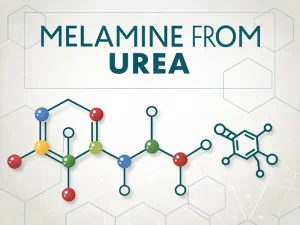
Melamine Packaging
Tech Blog Melamine packaging For manufacturers, inaccurate packaging not only fails to meet national standards but also increases labor costs and the risk of product

Melamine formaldehyde (MF) resin is a widely used thermosetting polymer known for its heat resistance, durability, and chemical stability. From laminated countertops to flame-retardant coatings, their applications span multiple industries. The melamine formaldehyde resin reaction is a key process in polymer chemistry, and understanding it is crucial for optimising resin properties, controlling production costs, and innovating applications.
The reaction starts with melamine (a nitrogen-rich organic compound) and formaldehyde (a simple aldehyde). When these two compounds are mixed under controlled conditions (usually with a catalyst and heating), they undergo a series of chemical reactions.
The process can be summarised as follows:
Initial reaction: Melamine and formaldehyde react to form a linear polymer structure called a prepolymer.
Condensation reaction: As the response proceeds, water molecules are removed, ultimately forming a three-dimensional network. This step is crucial as it imparts thermosetting properties to the resin.
After the prepolymer forms, it must be cured to achieve the final performance. The usual practice is to apply heat and pressure to crosslink and harden the resin. The curing process can improve the strength, heat resistance, and durability of the resin.
Even with strict control, the melamine formaldehyde reaction may still pose issues affecting the resin’s quality. The following are the main challenges and solutions:
Unreacted formaldehyde in cured resin may release toxic gases, violating safety standards such as EU REACH restrictions.
Solution: Adopt a lower M: F ratio (1:2.5-1:3) and extend the condensation time to promote complete reaction. Adding formaldehyde scavengers (such as urea) after the reaction can also bind residual formaldehyde.
Rapid, uncontrolled crosslinking during production can cause the resin to solidify in the reactor, leading to batch waste.
Solution: Closely monitor pH; avoid sudden drops below 4. The second stage uses gradual heating, and, if necessary, inhibitors (such as methanol) are added to slow crosslinking.
Resin with insufficient crosslinking will absorb water, expand or degrade in humid environments.
Solution: Increase the M: F ratio (1:4-1:5) and prolong the condensation time at 100-120 °C to improve crosslinking density.
Laminated board and decorative surface
Highly crosslinked MF resin is used to bond paper or fabric layers into laminates. Its hard, scratch-resistant surface and water resistance make it an ideal choice for countertops and furniture.
Moulded products
MF resin is mixed with fillers to produce moulded plastics, which are then compressed into heat-resistant and rigid products such as electrical switches, tableware, and automotive components.
Adhesives and Coatings
Low crosslinking resins can be used to make flexible woodworking adhesives (especially for outdoor applications, as they offer better water resistance than UF resins). They can also be coated on metal surfaces to resist corrosion, utilising the chemical inertness brought by controlled crosslinking.
Flame-retardant materials
MF resin releases nitrogen gas during combustion, which can suffocate flames. This flame-retardant property (enhanced by increasing crosslinking) makes it crucial for textiles, insulation materials, and building materials.
The melamine formaldehyde resin reaction is a key step in preparing high-durability, multifunctional resins. Understanding this reaction and its characteristics can help manufacturers apply its potential to various fields, from construction to consumer goods. As multiple industries continue to seek materials that combine high performance and sustainability, melamine formaldehyde resin will remain an essential player in the polymer field.

Tech Blog Melamine packaging For manufacturers, inaccurate packaging not only fails to meet national standards but also increases labor costs and the risk of product

Tech Blog How to Detect Melamine in Textiles? Melamine powder, a nitrogen-containing heterocyclic compound, is widely used in flame-retardant textiles and plastic products due to

Tech Blog melamine from urea Melamine is well-known for its wide range of applications, but its raw material for production is surprisingly urea. For manufacturers,

JINGJIANG MELAMINE POWDER
© JINJIANG MELAMINE